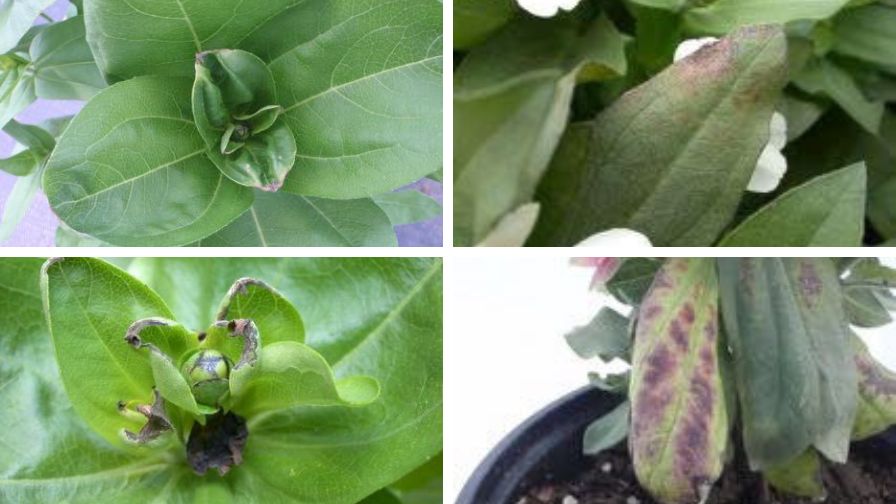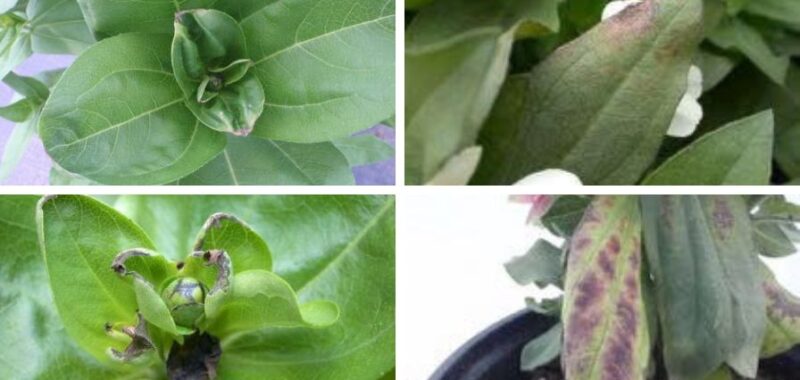
Zinnias with calcium (L) and magnesium (R) deficiencies | Brian Whipker
The production of plants in the summer season can “lead to unique symptomology that is not typical during other times of the year,” Brian E. Whipker and Patrick Veazie of North Carolina State University write in their pair of recent e-Gro alerts. This, in turn, led to an investigation of such effects on a host of summer crops, including zinnias.
Zinnia – Tip Burn
A common symptom of zinnia summer production is tip burn, which “occurs primarily on the set of leaves that form the whorl around the flower bud,” but older leaves can also exhibit symptoms in more extreme cases, leading to possible Botrytis infection due to the presence of dead leaf tissue.
The cause of this phenomenon, according to Whipker and Veazie, points to calcium deficiency. Additionally, experiments were run at NC State to verify and confirm this thesis as the cause.
Calcium Deficiency in Zinnias
Whipker and Veazie cite past and applicable research of tip burn on Stargazer lilies by Dr. Bill Miller of Cornell University, stating “When the young leaves surrounding the flower bud are forming, that enclosed environment at the growing tip lacks airflow. Calcium uptake by plant roots and transportation within the plant is driven by water loss (transpiration) from the leaves. If the humidity is excessive, water loss decreases, and calcium (and boron) uptake is also limited.”
With calcium acting as the “primary building block of plant cells,” the flower bud on zinnias is essentially sucking up most of the limited nutrient. In turn, that causes its surrounding leaves to initiate cell death as they attempt to grow without a sufficient amount of calcium.
Management and Solutions for Zinnia Calcium Deficiency
Whipker and Veazie suggest the following options for the management and prevention of calcium deficiency in zinnias:
- Control excessive humidity
- Increase airflow
- Maintain substrate pH
- Provide adequate calcium
However, the pair stress that “control of this environmentally induced, physiological disorder is a challenge.”
Additionally, they suggest that calcium sprays are an option, but that research into the tool is still ongoing and unfounded, with additional trials needed to document its effectiveness.
Zinnia – Lower Leaf Yellowing
Lower leaf interveinal chlorosis, or yellowing, is often evident on zinnias during summer production, which can advance into necrotic (reddish-brown) spotting. While this symptom can be confused with the cause of “low pH iron/manganese toxicity,” Whipker and Veazie state that it’s more likely due to a limited amount of magnesium. This causes the translocation of nutrients to more vital parts of the plant, leading to deficiency in older tissue.
Magnesium Deficiency in Zinnias
Because of its presence in many sources of groundwater in North America, the need for magnesium is often overlooked by many growers. However, not all grower locations have such an abundance of the element, leading to trouble with plants, and, in this case, zinnias.
Additionally, other nutrients/elements can limit a plant’s ability to properly absorb magnesium. Whipker and Veazie provide an example of elevated levels of calcium or potassium in crops, which can limit the uptake of magnesium, leading to a deficiency and the problems that come with it.
Management and Solutions for Zinnia Magnesium Deficiency
In contrast to the problem of calcium deficiency in zinnias, the solution for magnesium deficiency has a much simpler and straightforward solution. That would be the application of Epsom salts, which will stop the progression of symptoms but not reverse necrotic spotting on leaves.
For more information regarding the cause and solutions to nutrient deficiencies in zinnias, please read the full e-Gro (Electronic Grower Resources Online) alerts “Zinnia: Leaf Tips Gone Bad,” and “Zinnia: Missing Magnesium.” Additional and current e-Gro alert pieces from Volume 13 (2024) can be found online.

